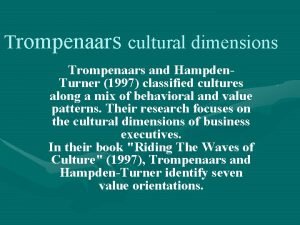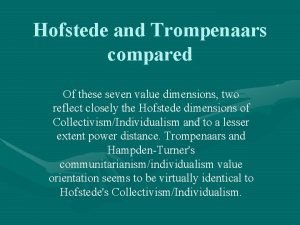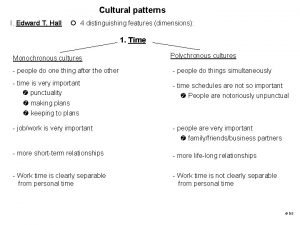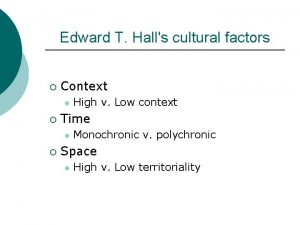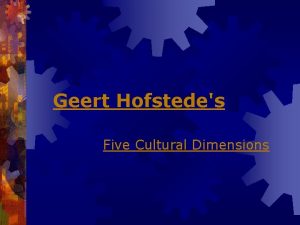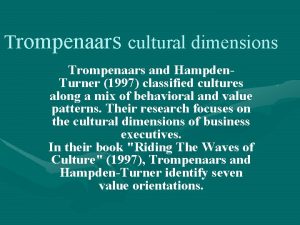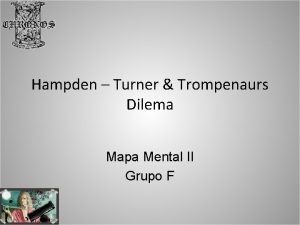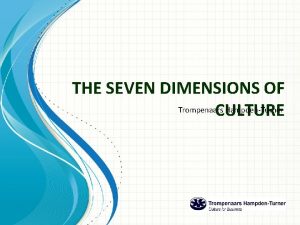Trompenaars cultural dimensions Trompenaars and Hampden Turner 1997










- Slides: 10

Trompenaars cultural dimensions Trompenaars and Hampden. Turner (1997) classified cultures along a mix of behavioral and value patterns. Their research focuses on the cultural dimensions of business executives. In their book "Riding The Waves of Culture" (1997), Trompenaars and Hampden-Turner identify seven value orientations.

• Some of these value orientations can be regarded as nearly identical to Hofstede's dimensions. Others offer a somewhat different perspective.

5 • The seven value dimensions identified were: 1)Universalism versus particularism 2)Communitarianism versus individualism 3)Neutral versus emotional 4)Defuse versus specific cultures 5)Achievement versus ascription 6)Human-Time relationship and

Lessons for MNCs • The lessons that MNCs can draw from Trompenaars findings are many. Here are some examples: Universalism versus Particularism: Companies from universalistic cultures negotiating with a potential joint venture partner in China must recognize that relationships matter and take time to develop. They form the basis of the trust that is necessary in order to do business. In a particularistic culture, contracts are only a rough guideline or approximation.


• Communitarianism versus Individualism: Companies from individualistic cultures such as the USA will face difficulties in introducing methods of individual incentives such as pay-for-performance and individual assessment in subsidiaries in communitarian cultures such as Germany or Japan.

• Neutral versus Emotional: Multinational teams consisting of individuals from highly neutral and highly affective cultures need careful management and considerable intercultural understanding. Otherwise, the affective persons will view the neutral persons as ice-cold, and the affective persons will be viewed as out of control by the neutrals.

• Specific versus Diffuse: Managers from specific cultures such as Denmark are much more prone to criticize subordinates directly and openly without regarding their criticism as a personal matter. In the context of a subsidiary in a diffuse culture such as Russia, this may constitute an unacceptable loss of face.

• Achievement versus Ascription: Sending a young manager to run a subsidiary in a traditional culture such as India will involve difficulty. Likewise promoting younger people within the subsidiary on the basis of their performance.

• Time Orientation The time orientation dimension has two aspects: the relative importance cultures give to the past, present, and future, and their approach to structuring time. If a culture is predominantly oriented towards the past, the future is often seen as a repetition of past experiences.
 Trompenaars and hampden-turner cultural dimensions
Trompenaars and hampden-turner cultural dimensions Trompenaars dimensions
Trompenaars dimensions Trompenaars seven cultural dimensions
Trompenaars seven cultural dimensions Hall's cultural dimensions
Hall's cultural dimensions Trompenaars 7 cultural dimensions
Trompenaars 7 cultural dimensions Acculturation studies ib psychology
Acculturation studies ib psychology Edward t hall cultural dimensions
Edward t hall cultural dimensions Edward t hall cultural dimensions
Edward t hall cultural dimensions 7d cultural dimensions model
7d cultural dimensions model Five cultural dimensions
Five cultural dimensions Outsourced movie cultural dimensions
Outsourced movie cultural dimensions
